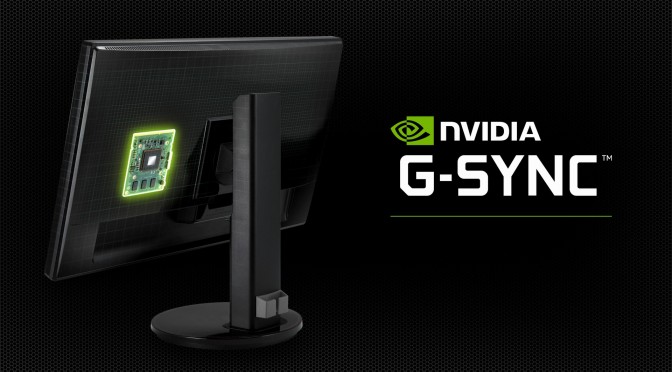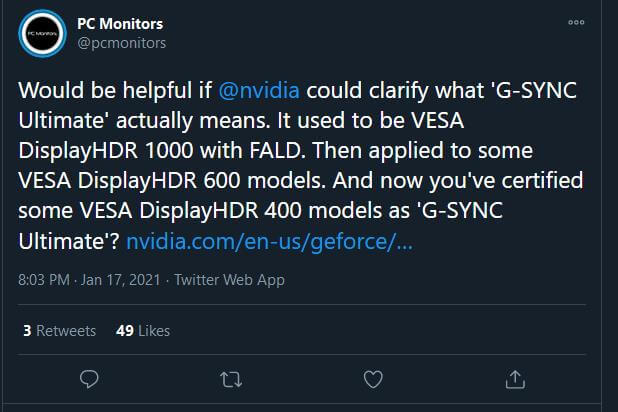It appears that Nvidia has silently lowered its G-SYNC Ultimate standards, allowing it to release a larger quantity of monitors, and thus create a larger market for its latest G-SYNC display modules for users.
Twitter user PCMonitors has just spotted a recent change in the specification listed on Nvidia’s website which effectively hints at a downgrade, when it comes to the requirements for the top G-SYNC Ultimate definition, from VESA DisplayHDR 1000 to merely a generic ‘lifelike HDR’ standard instead.
G-Sync Ultimate webpage specification has been changed from “Best HDR 1000 Nits” to an entirely unspecific requirement “Lifelike HDR“. Since then, Nvidia has only revealed G-SYNC Ultimate monitors that do not meet the VESA DisplayHDR 1000 standard.
The most recent G-SYNC spec page can be found here, whereas the old archive page link can be found here. Nvidia plans to broaden the G-SYNC platform and ecosystem, and it can only achieve this by doing some apparent downgrades or changes to the DisplayHDR specification.
But since Nvidia wants to release a large quantity of G-SYNC Ultimate monitors; they are now lowering their standards in order to achieve this goal.

Image credit: Videocardz.
Before this change from Nvidia, the most advanced G-SYNC ultimate specification required VESA DisplayHDR 1000 certification with ‘over’ 1000 nits of brightness performance, but sadly this isn’t the case anymore.
Previously, Nvidia only listed the best HDR monitors as being certified as G-SYNC Ultimate that required a Full-Array Local Dimming (FALD) backlight, Nvidia’s G-Sync ultimate Module and VESA DisplayHDR 1000-grade HDR. But now, DisplayHDR 600 and DisplayHDR 400 monitors are only revealed as G-Sync ultimate displays.
As a matter of fact, at this year’s CES 2021 event, MSI’s MEG MEG381CQR and LG’s 34GP950G were announced with an NVIDIA G-Sync Ultimate certification/badge, despite only featuring HDR 600 certifications from VESA. This certainly further complicates the matter for users/gamers.
Now, most of the Buyers may be required to properly check for the Ultimate badge in order to know they’re getting the best gaming monitors, as per the guidelines outlined by NVIDIA. But do make a note that Nvidia has not made this public yet. The company just silently changed and lowered the G-Sync specification on their official webpage.
There is still some confusion regarding the exact G-Sync certification. As per few recent market surveys, VESA DisplayHDR 1000 monitors are still rare within the PC market, so it makes sense for the company to update and change its standards to make them achieve the G-Sync Ultimate standard. Most OLED TVs also cannot meet DisplayHDR 1000’s brightness requirements.
As PCGamer noted, “Unfortunately, Nvidia’s own marketing material is thoroughly ambiguous. It stipulates that the Ultimate tier requires the ‘top NVIDIA G-SYNC processors’ referring to the G-Sync modules or boards that used to be required for all G-Sync monitors.
Meanwhile, the bottom G-Sync Compatible tier is denoted as not using Nvidia processors. But there’s no mention of modules one way or the other for the middle ‘G-Sync’ tier.”
“We’ve reached out to Nvidia for clarification.”
NVIDIA has never revealed the full specifications that are required to meet the Ultimate standard. However, the recent marketing materials now paint a totally different picture. We hope Nvidia will clarify its updated HDR Ultimate specifications soon because the end-users deserve to know more about the whole G-SYNC ecosystem they are buying into.
Stay tuned for more tech news!
UPDATE:
NVIDIA has sent Guru3D an official statement about this.
“Late last year we updated G-SYNC ULTIMATE to include new display technologies such as OLED and edge-lit LCDs. All G-SYNC Ultimate displays are powered by advanced NVIDIA G-SYNC processors to deliver a fantastic gaming experience including lifelike HDR, stunning contract, cinematic color and ultra-low latency gameplay. While the original G-SYNC Ultimate displays were 1000 nits with FALD, the newest displays, like OLED, deliver infinite contrast with only 600-700 nits, and advanced multi-zone edge-lit displays offer remarkable contrast with 600-700 nits. G-SYNC Ultimate was never defined by nits alone nor did it require a VESA DisplayHDR1000 certification. Regular G-SYNC displays are also powered by NVIDIA G-SYNC processors as well.”
Hello, my name is NICK Richardson. I’m an avid PC and tech fan since the good old days of RIVA TNT2, and 3DFX interactive “Voodoo” gaming cards. I love playing mostly First-person shooters, and I’m a die-hard fan of this FPS genre, since the good ‘old Doom and Wolfenstein days.
MUSIC has always been my passion/roots, but I started gaming “casually” when I was young on Nvidia’s GeForce3 series of cards. I’m by no means an avid or a hardcore gamer though, but I just love stuff related to the PC, Games, and technology in general. I’ve been involved with many indie Metal bands worldwide, and have helped them promote their albums in record labels. I’m a very broad-minded down to earth guy. MUSIC is my inner expression, and soul.
Contact: Email


